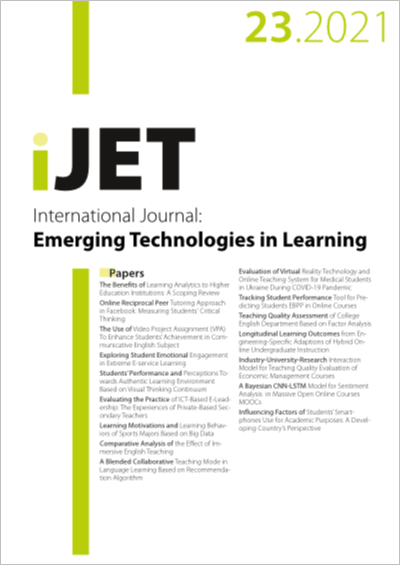Students’ Performance and Perceptions Towards Authentic Learning Environment Based on Visual Thinking Continuum
DOI:
https://doi.org/10.3991/ijet.v16i23.27455Keywords:
Authentic learning environment, continuum visual thinking, visual-based website, visualizationAbstract
This paper explores the changes in student’s level of achievement and per-ception towards authentic learning environment based on visual thinking elements. The three elements in visual thinking continuum are visual thinking, visual learning and visual communication. This research is a quan-titative design involving quantitative and qualitative data. Research instru-ments included pre and post achievement tests, and a questionnaire on stu-dent’s perception towards visualization level. There are 29 samples students, from teacher training first degree program in one of Malaysian public univer-sities. The research data were analyzed by inferential and descriptive statisti-cal analysis. Research findings through paired-sample t-test showed that there is a significant difference between scores of mean for the pre-test and post-test (p< 0.05) and shows positive student’s perception towards authen-tic learning environment. All students have experienced positive growth in their level of visualization through authentic learning environment activities which based on visual thinking elements. Therefore, it can be concluded that the visual-based website has helped to enhance the students’ performance and visualization levels.
Downloads
Published
2021-12-08
How to Cite
Atan, N. A., Tasir, Z., Ali, M. F., Rosli, M. S., & Mohamad Said, M. N. H. (2021). Students’ Performance and Perceptions Towards Authentic Learning Environment Based on Visual Thinking Continuum. International Journal of Emerging Technologies in Learning (iJET), 16(23), pp. 56–73. https://doi.org/10.3991/ijet.v16i23.27455
Issue
Section
Papers
License
Copyright (c) 2021 Noor Azean Atan, Zaidatun Tasir, Mohd Fadzli Ali, Mohd Shafie Rosli, Mohd Nihra Haruzuan Mohamad Said

This work is licensed under a Creative Commons Attribution 4.0 International License.



